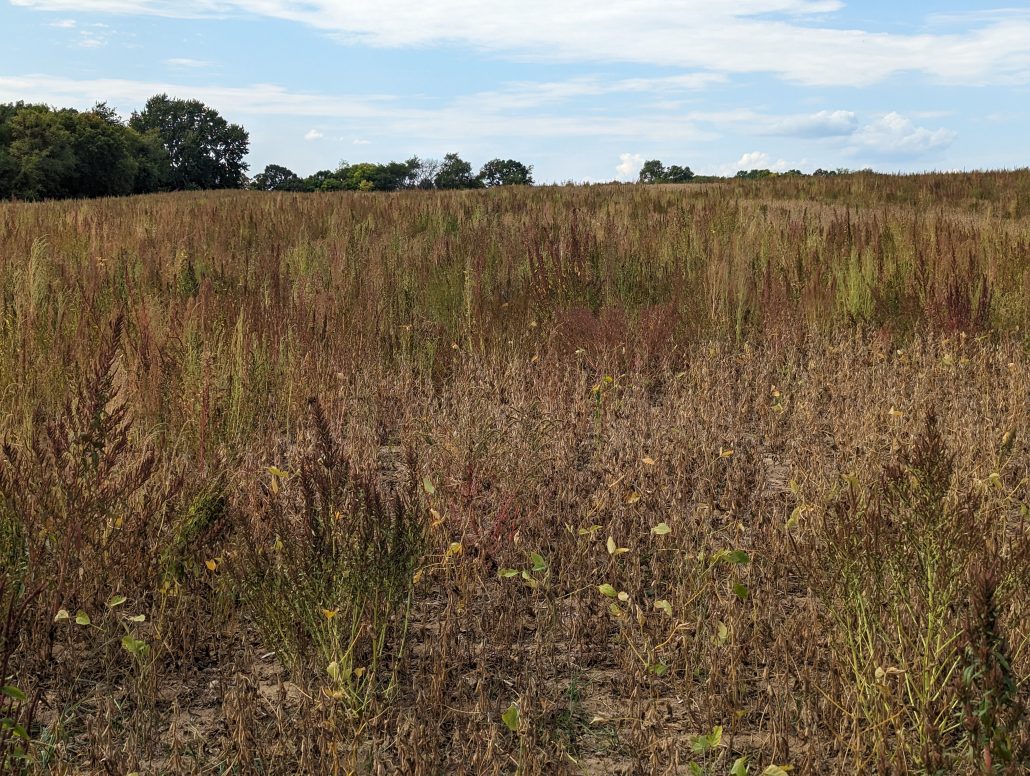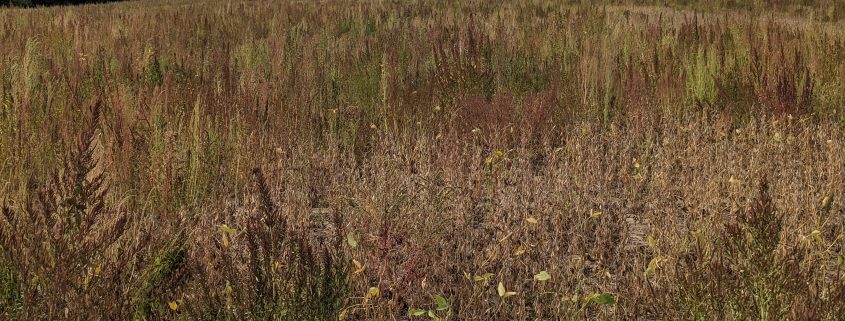Harvest Aid Considerations for Weedy Soybean Fields
Authored by: Sam Bibby, Regional Crops & Soils Educator- UW Madison Extension; Dr. Rodrigo Werle, Associate Professor and Extension Cropping Systems Weed Scientist- UW Madison; and Dr. Shawn P. Conley, Professor and Soybean & Small Grains Extension Funded Campus-Based Faculty- UW Madison
There are a lot of weedy soybean fields across Wisconsin this year and the dry conditions are the major culprit. A lack of precipitation reduced the effectiveness of many residual herbicides and drought- affected soybeans were slower to close the canopy. To make matters worse, the dry conditions seem to be accelerating soybean dry down while weeds remain green. In Wisconsin, we usually get a killing frost around early to mid-October. Fields with heavy weed pressure may not be physically harvestable until then. This leaves us with the very real possibility of harvesting too-dry soybeans from fields under heavy weed pressure.
Harvest loss from pod shatter increases significantly when soybeans get below 11% moisture or when they undergo several drying-rewetting cycles. As a rule of thumb, when measuring harvest loss, four seeds per square foot equate to a bushel per acre of yield loss. Shrink loss, caused by soybeans sold below 13% moisture is another large concern and often goes unnoticed. As an example, harvesting and selling soybeans at 9% moisture and $12 per bushel with an average yield of 40 bushels per acre will result in a loss of $21 per acre compared with the same harvest at 13% moisture. In 2023, a desiccant application may prove to be cost effective for growers with weed infested fields that are still expected to yield. Here are some points to consider:
- Sharpen (suflufenacil) is currently the main herbicide that is labeled for, and somewhat effectively desiccates, hard-to-control, potentially herbicide-resistant weeds like waterhemp, giant ragweed, marestail and common lambsquarters in soybeans.
- Glyphosate is an option for growers dealing with heavy grass weed pressure or may be tank mixed with Sharpen for burndown of some broadleaf weeds.
- Spray Sharpen at physiological maturity, stage R7, indicated by one mature-colored pod anywhere on the main stem.
- Sharpen may be applied at a rate of 1.5-2 fl oz per acre or 1-2 fl oz per acre when tank mixed with another desiccant. A minimum carrier volume of 10 gallons per acre for ground rigs and 5 gallons per acre for aerial application is recommended for desiccation. Higher carrier volume rates will increase burndown efficacy. MSO at 1% v/v and AMS at 8.5lbs/100 gal are recommended adjuvants.
- Maintain a pre-harvest interval of 3 days when using Sharpen or 7 days if glyphosate is used alone or in tank mix.
- Soybean fields sprayed with Sharpen for a harvest aid should not be harvested for seed or any form of feed/forage.
- Winter wheat for grain and other cereal grain cover crops, such as winter rye, may be planted following harvest of soybean fields sprayed with Sharpen. However broadleaf cover crops should be avoided following an application of Sharpen.
- Small grain forage and hay must not be fed or grazed sooner than 30 days after application.
Spot spraying weedy patches may also be a cost-effective method of ensuring the whole field may be harvested at once. Using a harvest aid such as Sharpen in Wisconsin may only be economical if it is likely harvest will be delayed significantly by weeds so it is important to get out and scout fields now to make that decision as soon as possible.
Sources:
https://www.cdms.net/ldat/ld99E014.pdf
https://cropwatch.unl.edu/2020/harvest-aid-herbicide-options-soybean
https://www.pioneer.com/us/agronomy/Timing-Soybean-Desiccation-As-A-Harvest-Aid.html
Application Timing of Harvest Aid Herbicides Affects Soybean Harvest and Yield. Joseph M. Boudreaux and James L. Griffin*https://www.mssoy.org/uploads/files/griffin-weed-tech-reprint.pdf



